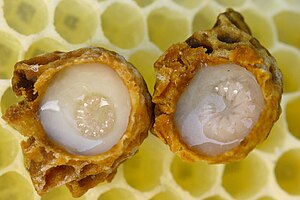
Royal jelly is a honey bee secretion that is used in the nutrition of larvae and adult queens.[1] It is secreted from the glands in the hypopharynx of nurse bees, and fed to all larvae in the colony, regardless of sex or caste.[2]

During the process of creating new queens, the workers construct special queen cells. The larvae in these cells are fed with copious amounts of royal jelly. This type of feeding triggers the development of queen morphology, including the fully developed ovaries needed to lay eggs.[3]
Royal jelly is sometimes used in alternative medicine under the category apitherapy. It is often sold as a dietary supplement for humans, but the European Food Safety Authority has concluded that current evidence does not support the claim that consuming royal jelly offers health benefits to humans.[4] In the United States, the Food and Drug Administration has taken legal action against companies that have marketed royal jelly products using unfounded claims of health benefits.[5][6]
- ^ Jung-Hoffmann, L (1966). "Die Determination von Königin und Arbeiterin der Honigbiene". Z Bienenforsch. 8: 296–322.
- ^ Graham, J. (ed.) (1992) The Hive and the Honey Bee (Revised Edition). Dadant & Sons.[page needed]
- ^ Maleszka, Ryszard (27 October 2014). "Epigenetic integration of environmental and genomic signals in honey bees: the critical interplay of nutritional, brain and reproductive networks". Epigenetics. 3 (4): 188–192. doi:10.4161/epi.3.4.6697. PMID 18719401.
- ^ "Scientific Opinion on the substantiation of health claims related to: anthocyanidins and proanthocyanidins (ID 1787, 1788, 1789, 1790, 1791); sodium alginate and ulva (ID 1873); vitamins, minerals, trace elements and standardised ginseng G115 extract (ID". EFSA Journal. 9 (4): 2083. April 2011. doi:10.2903/j.efsa.2011.2083.
- ^ "Federal Government Seizes Dozens of Misbranded Drug Products: FDA warned company about making medical claims for bee-derived products". Food and Drug Administration. Apr 5, 2010.
- ^ "Inspections, Compliance, Enforcement, and Criminal Investigations: Beehive Botanicals, Inc". Food and Drug Administration. March 2, 2007.